Tannic Panic! Issue #111: Wineymoon in New Zealand, Part 2 - Hawke's Bay, Martinborough & Central Otago
“Of all the phrases in the English language, of all the endless combinations of words in all of history, 'Cellar Door' is the most beautiful” - Drew Barrymore
As threatened, we’re back with “more” New Zealand, more wineries, and more KIWIS. To refresh your rapidly deteriorating memory (just me?), our last honeymoon post covered all that Waiheke Island has to offer, including “life-changing” Syrah and the biggest spider we’ve ever seen.
Today we continue “traveling south” (on the wrong side of the road) to Hawke’s Bay, Martinborough, and Central Otago. So pour yourself some waina and buckle up—we’re about to subject you to the torture known as “someone else’s vacation photos.”
Hawke’s Bay
New Zealand’s Hawke’s Bay region—set on the east coast of the proverbial North Island near the twin towns of Hastings and Napier—is the country’s second-largest winegrowing area after Marlborough. Its location on an old estuarine plain makes for a warm, sun-drenched growing season; in fact, it’s the warmest of New Zealand’s key vineyard regions and “enjoys” the longest sunshine hours. Its landscape is notably varied (LIKE TODAY’S YOUTH!), with shifts in soil composition, elevation, and vineyard orientation contributing to a broad spectrum of wine styles.
Among its “most prized” subregions is Gimblett Gravels, a stretch of heat-retentive, type A, free-draining gravel on the valley floor that has become especially “well-regarded” for red varieties, particularly Syrah and Bordeaux-style blends.
Though our time in Hawke’s Bay was limited, we managed to “squeeze in” visits to Craggy Range Winery and Mission Estate Winery — after all, what better way to taste the “regional terroir” than to spend our time tasting wines from a winery founded by an Australian billionaire and another founded by French missionaries?
Craggy Range is one of the better known producers in Hawke’s Bay, with wines that have garnered international attention for being “really really good.” Most notably, their premium Syrah, “Le Sol,” is among the most critically acclaimed wines in the country, consistently scoring in the mid to high 90 point range from “reputable critics.” Of course, in spite of opting for the royal treatment (the publicly available and relatively inexpensive winery tour and tasting), we were not offered a glass of this Syrah. We did get to taste some of their wines, however, including an outstanding 2013 Bordeaux style blend, “Sophia.”
Now I should note that we weren’t blown away by the Syrah they did pour us, but given how unique and generally outstanding the Syrah we previously had was, I was determined to get my grubby little mitts on a bottle of Le Sol, so I immediately bought one upon returning to the states (K&L sells it, interestingly for less than it was sold for at the estate). It’s currently in ye olde cellar, but rest assured you’ll all be the first to know how it went, “when it goes.”
Mission Estate is the oldest winery in the country, offering sparkling, dry reds, dry whites and sweet whites. So all the wines, basically. Were they great? Not really. Were they bad? No. They were middling, but the place is a slice of history and the property itself is beautiful. Plus, it’s priced accordingly, so the whole experience was absolutely worth it. If you find yourself in the area, you’ll enjoy visiting just to walk around and experience the “mise en scene.” There’s a restaurant inside too, and snacking there was the highlight, taste-bud-ually speaking.
Martinborough
Wairarapa, located at the southern end of New Zealand’s North Island, comprises several small vineyard areas spread across a broad geographic zone. The standout among them is Martinborough, a now-registered Geographical Indication (GI) that has earned international recognition for its Pinot Noir. While summer temperatures in the region can “run high” (LIKE ME!), significant diurnal shifts help preserve the acidity and structure that Pinot Noir “demands.”
Martinborough also has the distinction of completely upending Victoria’s worldview by helping her discover that she… likes chardonnay?? Pray for her.
But actually, don’t, because the Chardonnay coming out of Martinborough is, for me, some of the best I’ve ever had. They commonly struck a beautiful balance between the sharp and flinty zing of Chablis and the ripeness and elegant integration of oak in premium quality Sonoma Chardonnay. Bonus points for it being far less expensive, especially when adjusting for the conversion rate. Why Martinborough Chardonnay isn’t stomping its angry little feet all over the world stage is beyond me, but perhaps it’s only a matter of time.
Our first stop was Palliser Estate Winery, a winery Isaac tested himself all the way back in 2017. Though it’s been renovated and built out substantially since then, the wines remain exceptional.
The stand out wine in 2017 was a sweet riesling, but as the winery has shifted towards a completely organic model, the ability to allow grapes to ripen for a late harvest has dwindled (pest and disease prevention are too difficult), so they’ve discontinued that bottling along with all but the occasional off dry wine when the conditions of the vintage allow.
BUT NO MATTER, twas no hindrance to an all around good time, because we tasted out way through the full spread of their offerings, and it was nothing but hits. The highlight was the 2024 Chardonnay (the 2024 vintage, they informed us, is one for the record books, and by all personal accounts, these are facts).
Total Wine actually carries some wines from Palliser — their Sauvignon Blanc is well stocked and their Pinot Noir is accessible widely as well. According to the folks we spoke with at the Estate, the Chardonnay is also sent out in small quantities to the San Francisco location, so perhaps some is possible to find there, though we’re yet to see any evidence to support this based on our cursory “research.”
2024 Palliser Estate Chardonnay / 97 Points
Profile: Bruleed lemon, white peach, poached pear, baked apple, hazelnut, marzipan, toasted almond, flint, brioche, white tea
Palate: Dry, high acid, full body, low tannin, long finishGoddamnit, goddamnit. This wine is exceptional. Layered and rich with incredible complexity and concentration. I noted tannin in the palate description because this wine does in fact have some subtle oak tannins that just make it all that much cooler. Truly this is one of the best chardonnays out there for my tastes, so if you ever have a chance to grab a bottle — especially the 2024 vintage — you are required to do so. You are also required to inform me where you found it so I can stock up, because we made the life altering mistake of only bringing one bottle home with us. A mistake we’ll have to live with for the rest of our short, meaningless lives.
Score Breakdown: Balance 39 / Aroma & Flavor 19 / Concentration 15 / Length 15 / Complexity 9 = 97 Points (I)
Before shoving off for Wellington, we stopped at Ata Rangi for some lovely breakfast wine. Chardonnay and Pinot Noir, all very, very good, and several of their Pinots are available at K&L for you stateside folks to try should you be so inclined.
Every drop of wine we tasted in Martinborough was a hit. It’s “spitting distance” from Wellington, so if you ever find yourself wandering blindly around the shaky isles, make your merry little way to Martinborough. #NoRagrets
DID YOU KNOW… Wellington is home to an awesome wine bar, Noble Rot, that performs blind tastings on request, with the in-house somms choosing what to put in front of you and giving hints as desired (typically following a series of infuriatingly incorrect guesses… not that I’d know). Needless to say, we visited said establishment a few billion times over the course of the three days we were in Wellington for an unspeakable number of blind tastings.
Central Otago
After cooling our heels a bit in Wellington, we whispered a sultry goodbye to the North Island and flew to Queenstown, almost as far south as you can get.
Central Otago sits inland, weasled into the foothills of the Southern “Alps” on New Zealand’s South Island. Vineyards are dispersed across a series of distinct valleys, each with its own combination of soil types, altitudes, and vineyard orientations and sneaky little vineyard fruits (THE GOOD KIND!).
Unlike most of the country’s “wine regions,” Central Otago has a continental climate, making it especially vulnerable (LIKE ME!) to frost in both spring and autumn. Summers are warm, and the growing season sees a pronounced diurnal range—key to preserving acidity and building flavor. High solar radiation contributes to elevated sugar levels, often translating to higher alcohol in the finished wines. Pinot Noir dominates plantings here, producing full-bodied, vibrant wines with concentrated red fruit “character.” Pinot Gris, Riesling, and Chardonnay also play a supporting role in the region’s portfolio.
The winery highlight of the region for us was Peregrine winery, where we had some more exceptional Chardonnay and Pinot, and an incredible 2015 Riesling, of which we procured a bottle for the cellar.
We came, we drank, we ended up buying a dedicated wine suitcase for the bottles we absolutely swore we wouldn’t buy. We can’t wait for our next visit.
Until next time, HAPPY DRINKING PEOPLE.
Cheers!
Isaac & Victoria (& Zach)









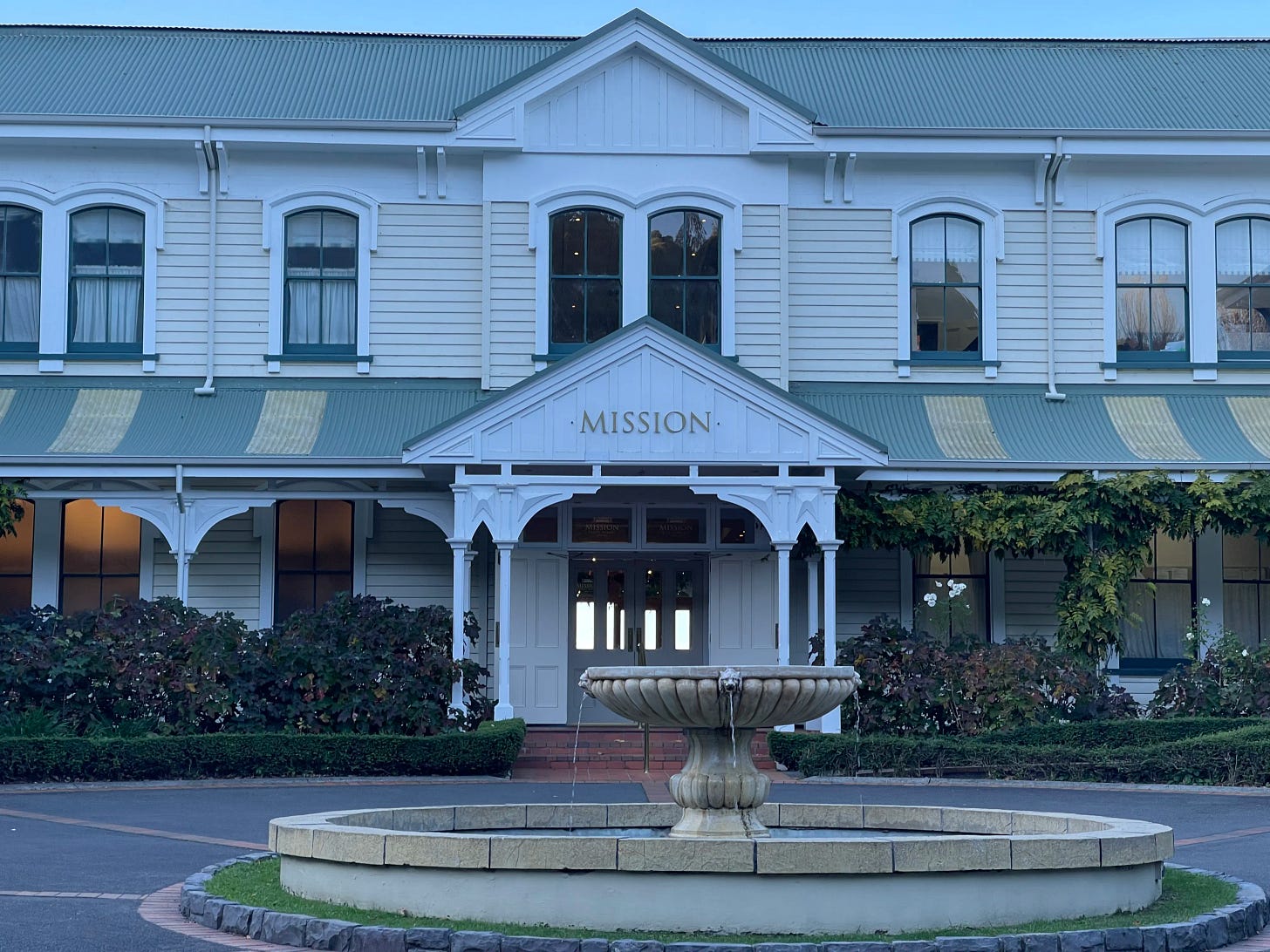

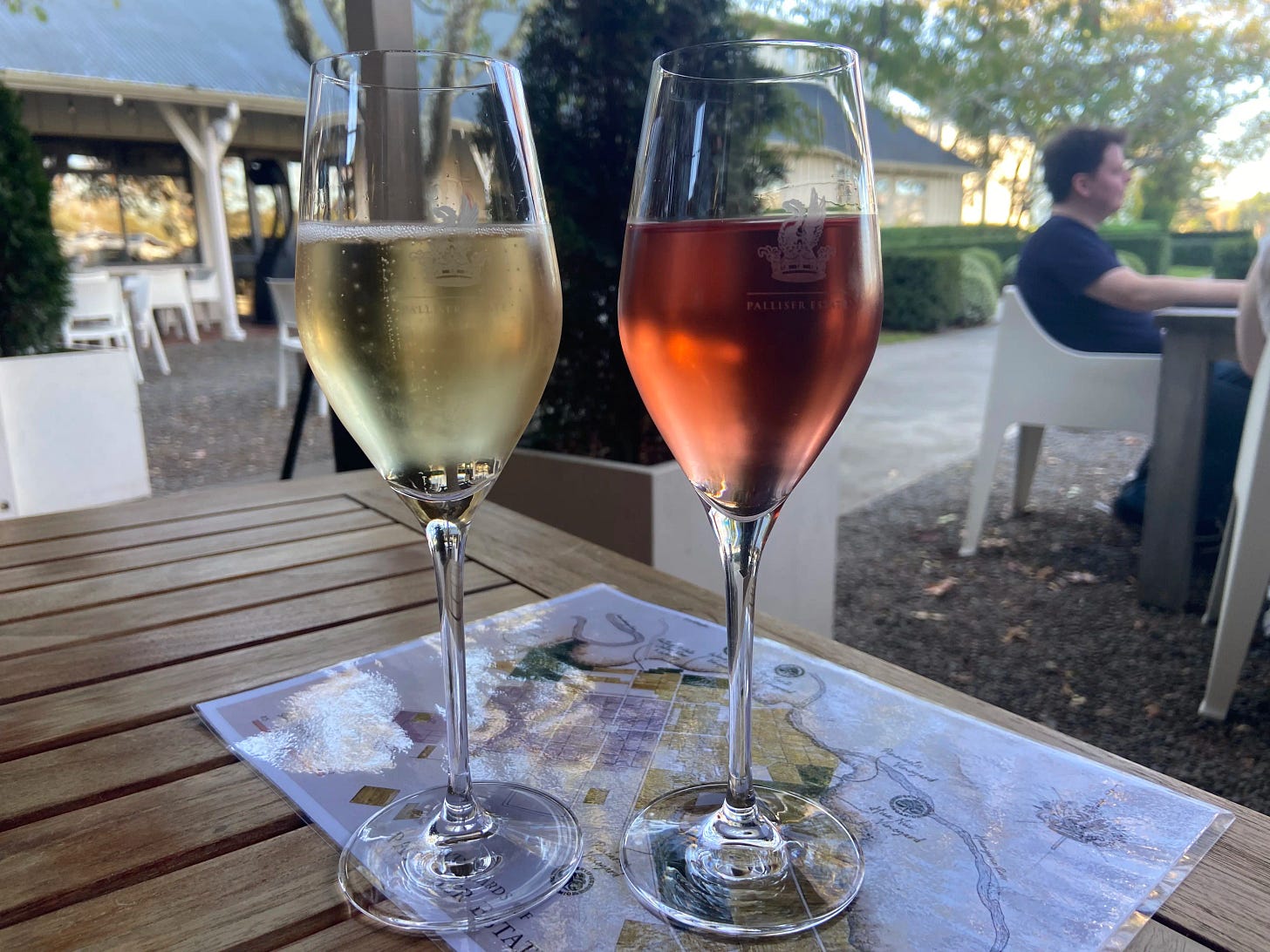

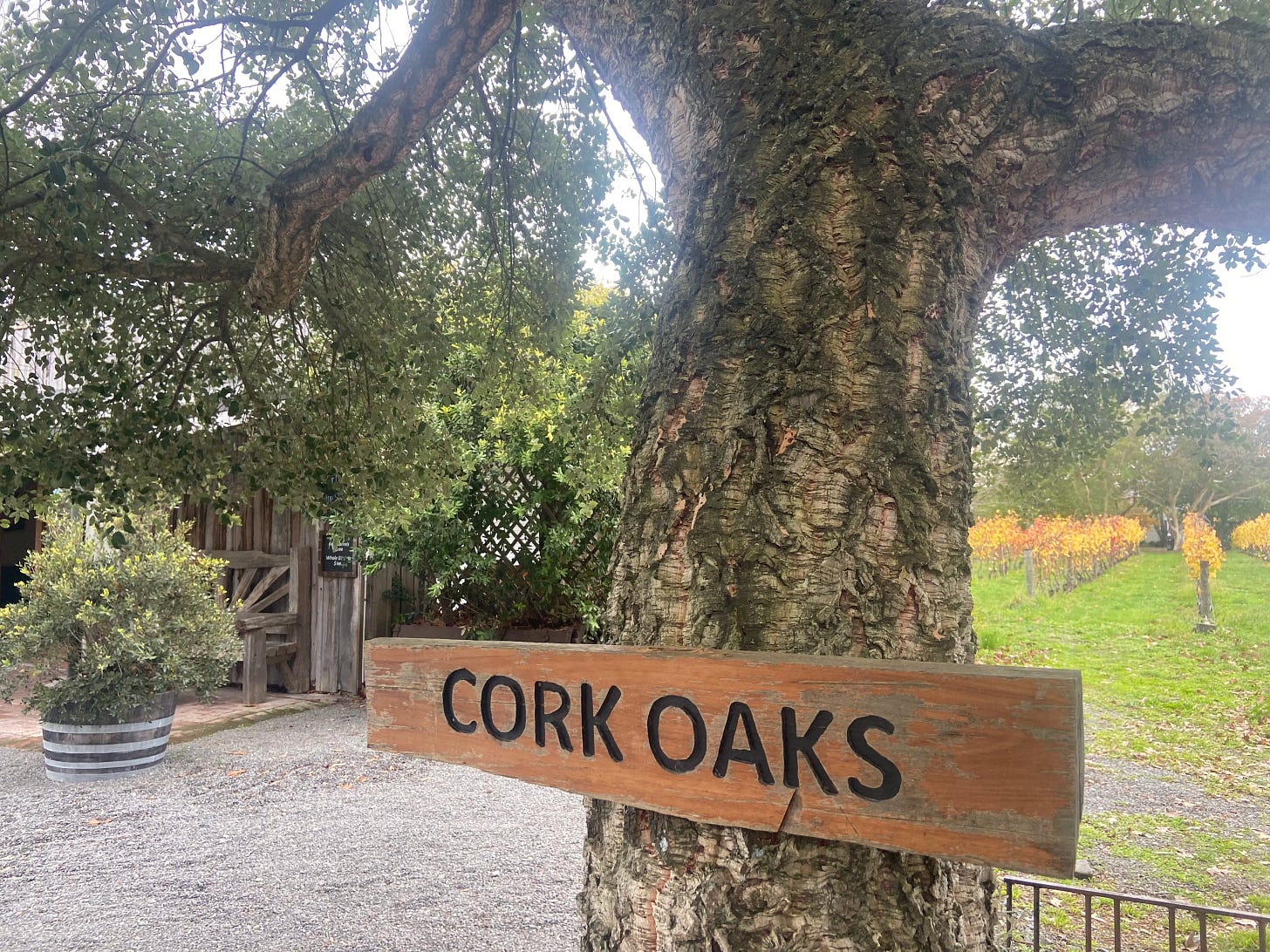
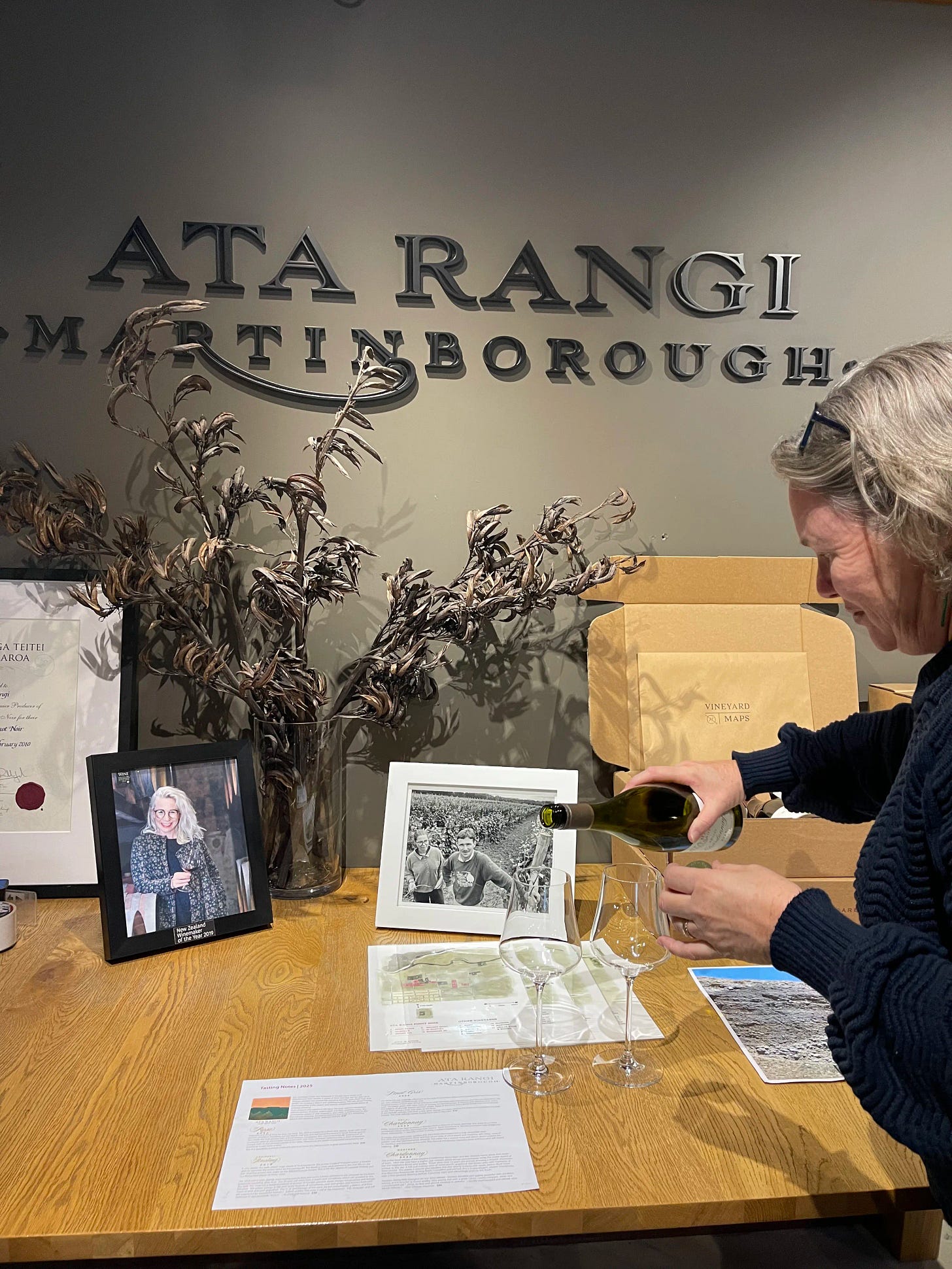
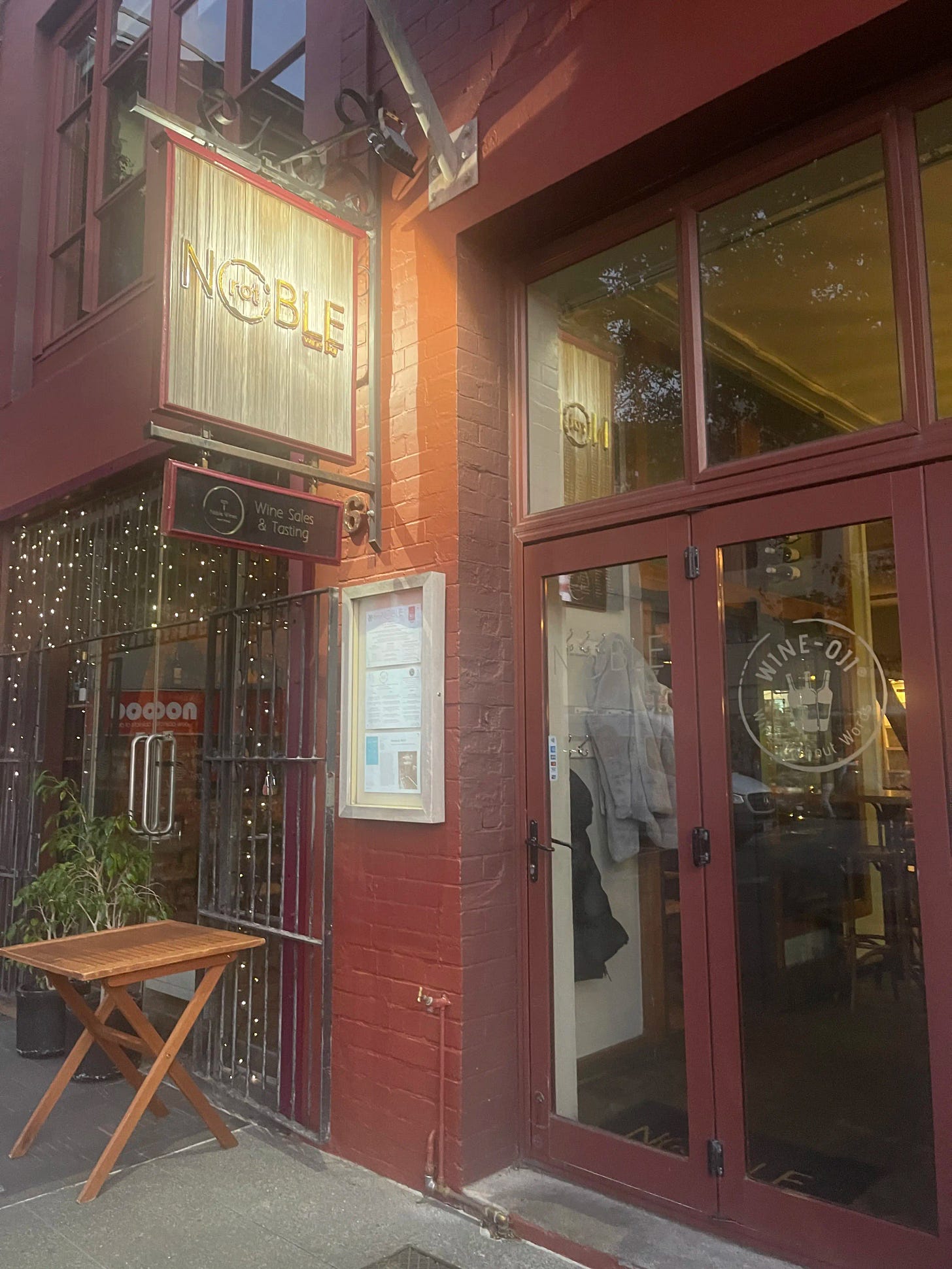



It's so bloody annoying that New Zealand has to be the other end of the planet (from me) and impossible to bring my dog - I'm desperate to visit (even have a mate in Central Otago) and very jealous of your Wineymoon! That said, I did get to try the Palliser Chardonnay (probably 2023 vintage) here in NL last winter. I thought it was absolutely excellent and everything I wanted in a Chardonnay. However, my tasting panel (aka boozy friends) did not agree: those who like oaky, buttery styles found it too acidic, and those who like lean, unoaked Chablis styles found it too oaky. So no one was happy except me 🙃
Very jealous you’ve been to Ata Rangi!